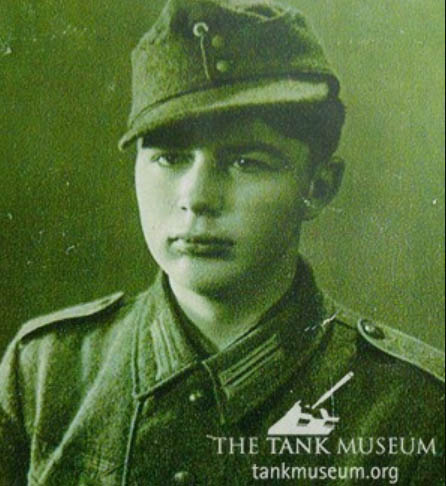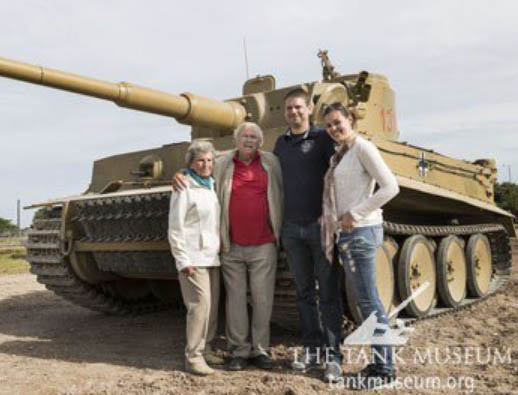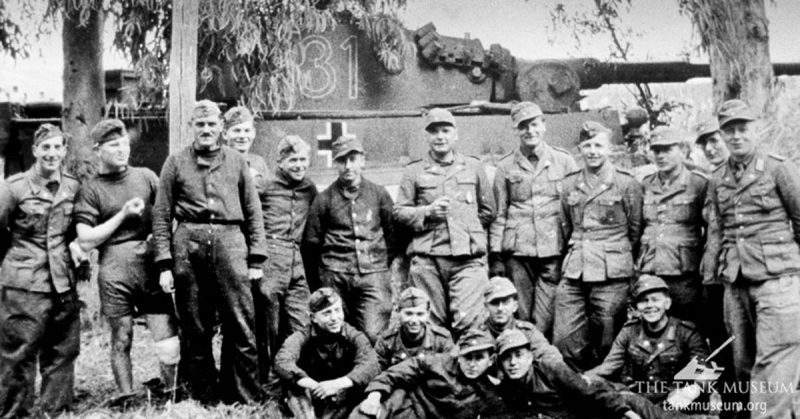The Tiger Collection features the memories of a number of veterans who fought in and against the Tiger. This short series of “Second World War Veteran” articles takes a more detailed look at the experiences of both British and German veterans. This first and the second part focuses on two German soldiers.
Wilhelm Fischer and Waldemar Pliska were both members of the Wehrmacht and used the Tiger in combat. Wilhelm joined the army at 17, in 1941 and was assigned to the 7th Panzer Division. Here he trained as a driver on Panzer II, Panzer III, Panzer IV and later retrained on the new Tiger I. As a young man of 17, Waldemar Pliska served in the 7th Panzer Division from 1943 as a tank driver in the Tiger I.
First Impressions
Fischer’s first impression of the Tiger was very positive: “Oh, what a tremendous thing; that is a whopping colossus of a tank! When you got in and it fired up for the first time and got going, it was really exciting.” Pliska was also impressed: “At that time the Tiger really was perfection to us, that’s what we thought. Technologically and also in firepower. Mechanically too…Even the name, Tiger, that meant to me; man that must be something scary. Fast, agile as a tiger. And as dangerous as a tiger.”

From the beginning, Pliska recognized that the Tiger was a step forwards from earlier tanks: “It was like day and night. The appeal, the automotive power, comfort, the technology… In the smaller tanks you really felt the road…It was 100% better.” However “the Tiger had certain characteristics, more refined than the ones we had come across in the other tanks.” This led to reliability problems, which prompted Fischer to recall that “There were more tanks in the workshops than there were fighting, probably!”
Combat
Quite apart from the danger, going into combat in a Tiger was a physical experience, especially firing the gun. “Do you know what a noise it made when you were inside?!” Fischer was told to “keep your mouth open so you didn’t burst your eardrums. If you closed your mouth, you could burst them.” Pliska agreed: “Yes, it really was loud. There was no sound insulation in the tank…We didn’t have earplugs, that was bad, but you just got used to it.”

Pliska also remembered his tank being hit: “It sounds like throwing a cup against the wall, but much louder! And dark, noisy. Dark noise. When you do not have any earplugs in your ears, then you begin to shake…”
Aside from the gun, Fischer “heard only the roar of the engine, nothing else. And nothing over the orders on the radio. Orders and nothing else.”
Living in the tank
Tigers served not only as weapons, but as their crew’s home. For Pliska, this required adjusting his understanding of what that word meant: “My concept of home was not what it was. It was dirty and smeared, everything was oily and now and then it leaked.” However, “That was my house at that time. It had everything in it you needed…The most important things like razors and toothbrush.”
Razors and toothbrushes may have been important, but hygiene more generally was not a priority. For Fischer it was “the last thing you think about.” He was dismissive of the whole concept: “Barely need to talk about it. Where would you want to have a wash? Where could you? You were happy enough just having enough to drink. Hygeine? Pff.”

During the summer both men would sleep outside the tank. Pliska preferred “barns that had been emptied,” whereas Fischer and his crew “dug a hole and then drove the tank over it. Then we slept in the hole… It was shelter, cover from shots and the like.“
They had different preferences during the cold winter. Fischer was happiest sleeping in the tank, as “Russian huts and shacks weren’t nice at all, they were all crawling with lice… I preferred to stay in the tank; it stank of petrol but there was no lice.” Unfortunately there was also no space: “You couldn’t lie down…You stayed sitting, hunkered down in our seats.” In contrast, still preferring to be outside, Pliska and his crew “slept around an oven.”
Looking back
Both men recalled the close bonds that existed between the Tiger’s five man crew. For Fischer it was “a relationship. It was like a little family. You had to stick together. One for all and all for one, that’s what it was.” Pliska remembered how they passed the time together: “I had a harmonica and we made music… One of us could sing really well, another always made jokes…, everyone did his bit for our little community.”

After the war Pliska’s “terrible experiences” stayed with him, “and I often dream of them still. I wake up drenched in sweat, because I can’t forget.” He knew he was safer in a tank than as an infantryman, “but…we still called them moving coffins…After my last tour, it was just a case of survival for me.”
For Fischer the memories eventually faded, but, “when I was younger, lying in bed, I would wake up in the morning soaking in sweat. Because I thought the Russians were coming.” Although he knew the Tiger could not win the war for Germany, he remained fond of the tank: “My Tiger. I was always pleased when I was in it, like being back home.”
A message from The Tank Museum:
“Please Support Us: As a charity, we rely on public support for all our activities. Our work is funded entirely by people like you. With your support, we can continue to create content. With the right support we might be able to do it more regularly – and can be even more ambitious. Please Click on the Banner Below.”
Thanks to the Tank Museum for this Blog, which originally appeared here and here.

